This is an Olympus Pen F, a single lens reflex camera that shoots 18mm x 24mm half-frame on regular 35mm film. The Pen F is part of the Olympus Pen series of half-frame cameras first introduced in 1959. The Pen F, like the original Pen was designed by Maitani Yoshihisa and cleverly disguises the viewfinder pentaprism by mounting it and the reflex mirror sideways within the body to maintain a flat top plate. The Pen F uses a unique bayonet lens mount and had a whole selection of interchangeable lenses made for it. A two prong bayonet around the shutter speed selector allowed for an optional coupled light meter to be used with the camera. Although it is not the only 35mm half-frame SLR, it is arguably the most sought after by collectors and users equally.
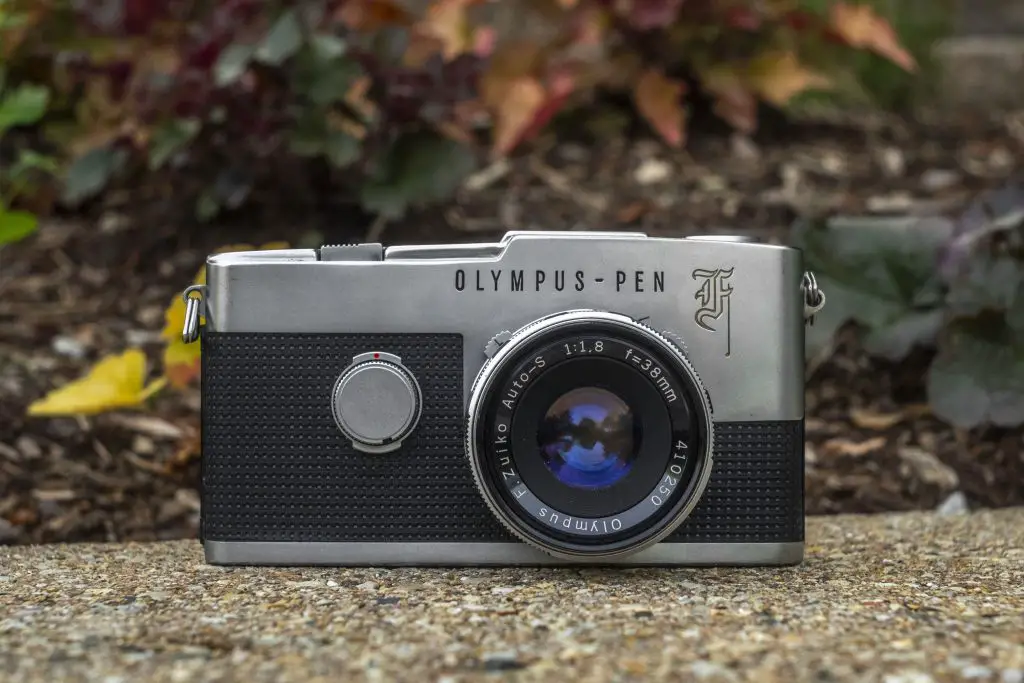 Film Type: 135 (35mm) 18mm x 24mm Half Frame
Film Type: 135 (35mm) 18mm x 24mm Half Frame
Lens: 38mm f/1.8 Olympus F.Zuiko Auto-S coated 6-elements
Lens Mount: Olympus Pen Bayonet
Focus: Variable if SLR, 2.6 feet to Infinity with Click Stops for Portrait, Group, and Scenery
Viewfinder: Fixed SLR Porroprism
Shutter: Rotary Metal Focal Plane
Speeds: B, 1 – 1/500 seconds
Exposure Meter: None (Optional Meter Attachment was available)
Battery: None
Flash Mount: PC Port M and X Flash Sync (Electronic Sync at all Speeds)
Weight: 579 grams (w/ lens), 441 grams (body only)
Manual: https://www.cameramanuals.org/olympus_pdf/olympus_pen_f.pdf
How these ratings work |
The Olympus Pen F is a half frame 35mm SLR that features all of the benefits of an SLR in a rangefinder form factor. With clean lines, good ergonomics, and excellent lenses, images shot with it look nearly as good as those from a full frame 35mm SLR. The overall design of the camera is clever, with a sideways prism, hidden inside of the body, plus a unique titanium rotary shutter that allows for full flash sync at all speeds. This is one of the most important cameras of the 20th century and a model that every collector should try at least once. | ||||||
| Images | Handling | Features | Viewfinder | Feel & Beauty | History | Age | |
| 2 | 2 | 1 | 1 | 2 | 2 | 20% | |
| Bonus | +1 for historical significance and excellence | ||||||
| Final Score | 13.0 | ||||||
History
Oskar Barnack, August Nagel, Walter Dorwin Teague, and Masahiko Fuketa are all names that come to mind when thinking of influential camera designers of the 20th century. Without them, we may not have Leicas, Retinas, Bantam Specials, or the Nikon F today. While each of these four men have earned their places as great designers, there is another man who is just as deserving to be spoken of with the same level of reverence.
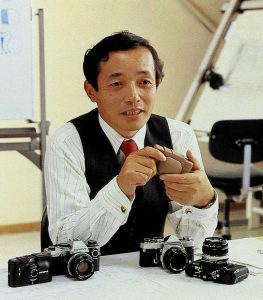
Yoshihisa Maitani was born January 8, 1933 in Kagawa Prefecture, Shikoku, Japan, and was the youngest son of a rice wine and soy sauce maker. Young Maitani had an interest in cameras, building his own rudimentary design at the age of 10 but when he attended college at Tokyo’s Waseda University, he pursued a degree in mechanical engineering and specialized in automobile engines. While studying in school it is said that Maitani took many photographs with a Leica IIIf which he loved, but found it to be limiting in closeup work. When he would encounter a situation in which the Leica wasn’t ideal for the type of photograph he wanted, he came up with designs of cameras that would meet his needs. In his free time, Maitani designed a unique new camera which he applied a patent for, although had no intention of ever putting it into production.
After college, Maitani got a job working for an automobile company, but a chance encounter by Eiichi Sakurai, a noted camera designer and Director of the camera development division of Olympus Optical Co. Ltd., discovered the patent filed for by Maitani and was so impressed, in 1956 he persuaded him to come work for Olympus.

For the first two years, Maitani worked in the camera design department on small projects previously started by someone else, but in 1958 was given his own assignment to design an all new and inexpensive camera that could be built and sold for no more than 6000 Yen. This was an ambitious goal as the next cheapest camera in Olympus’s lineup at the time was 23,000 Yen. Converting historical international currencies to current US dollars is often very difficult, but according to the the currency converter at historicalstatistics.org, 6000 yen in 1956 is equal to about $129 today. Other than the targeted price, the only other guideline given to Maitani was that the camera couldn’t be a toy. It had to be a quality camera that lived up to Olympus’s reputation.
Maitani was up to the challenge and approached the design of his new camera from the perspective he shared while shooting with his Leica. He thought the camera should be an extension of the photographer. It should be small and easy to use so that the photographer did not have to bother himself with confusing controls. He thought the camera should be secondary to the photographic process. Early on, the design of the body of the camera was given to a third party industrial designer. Unhappy with the early mock ups of the camera, Maitani took over full design himself.

A second priority to the design and use of the camera would be it’s lens. Although the targeted price point he was working with suggested a cheap single or double element lens, Maitani wanted something better. He aimed for something comparable to a 4-element Zeiss Tessar. Maitani convinced Olympus lens designer Yoshisada Hayamizu to create an all new compact wide angle lens that would meet both the camera’s quality and financial goals.
Cost was a major factor in designing the camera. Nearly the entire budget for the camera was put into it’s lens, so Maitani had to get creative with the rest of the camera. Things like the wind lever were simplified with a knurled plastic wheel that protruded out of the back of the camera. The body needed to be small and built with clean lines and a lack of clutter. The decision to make the new camera shoot 18x24mm “half frames” was born out of the need to make the camera as compact as possible. A smaller camera meant less parts and less money to build it. As a side benefit, shooting half frames meant a photographer would get double the amount of exposures per roll. Japan’s economy had not completely recovered from the war, and the cost of film and developing was still very high, so doubling exposures from a single roll would have been a huge benefit.
The decision to release a new half frame 35mm camera was very controversial. Although half frame 35mm cameras were common in the early parts of the 20th century, they had fallen out of favor by the end of the war. In 1958 when this camera was being designed, there were no other half frame 35mm cameras being produced anywhere in the world. The success or failure of this new model would largely hinge on whether or not people would accept a new half frame camera.
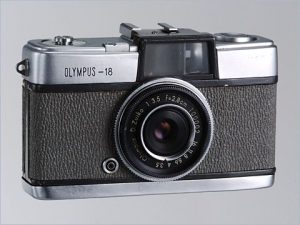
Over the next several months, Yoshihisa Maitani worked tirelessly on his new camera. He worked over time at work and even did some of the design at home. Olympus was already a respected Japanese optics company and Maitani was still a newcomer. His 6000 Yen project was considered low priority within the company and as a result, few people took notice of what he was doing, so he was largely free to do whatever he wanted with little oversight.
By the time Maitani was ready to reveal his camera to senior members of the company, he had built 5 prototypes to show off what he had been working on. Upon seeing the new prototypes, his superiors were hugely impressed with not only the design of the camera, but what Maitani was able to accomplish at such a meager price point. No one at the company took a 6000 Yen camera seriously, especially one designed by a junior employee, yet here was a camera with good looks, great ergonomics, and a very capable lens.
When it came time to release the camera in October 1959, the camera was given the name “Pen” as it was supposed to fit in a shirt pocket in the same place where an engineer might keep a pen. Despite excitement generated by the new camera, leadership at Olympus still considered the camera a novelty and refused to build it themselves, instead outsourcing production of the camera to a third party called Sanko Shoji. From a lecture given by Maitani in October 2005 about the development of the Pen, he says:
…my prototype was about to go into production, and I was excited. But even though the decision to produce my camera had come from the very top, the factory manager refused to manufacture my “toy camera.” Half-size cameras didn’t exist then, and sales executives told us that my camera wouldn’t sell because there was no market for it.
Accepted wisdom told us that the camera couldn’t be made and wouldn’t sell. Since our factory wouldn’t make it, we decided to outsource production. That was how the Pen first came into being. And as soon as it went on sale, it became a best-seller…
The Pen was an immediate success selling over 30,000 units in the first couple of months of production. Due to the huge demand for the camera, Olympus took over production in early 1960 and started to expand on the Pen product line with more advanced models.
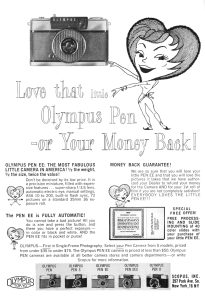
Over the course of the next few years, a huge number of Pen cameras were released, some with faster f/2.8 lenses, some with wide angle lenses, and eventually some with light meters and automatic exposure. The first metered Pen was the Pen EE from 1961. It featured a coupled selenium light “electric eye” meter that allowed the camera to automatically expose images.
Even before he started working on the original Pen, Maitani had the idea of making a half frame SLR. The technology to create such a camera did not yet exist, so most of his ideas only existed in his notebooks. With the immense popularity of the Pen, people began to demand a half frame SLR and one day Eiichi Sakurai came to Maitani and asked for his thoughts.
After being shown his original sketches, Sakurai gave Maitani the green light to start working on the camera. Unlike when he first started, Yoshihisa Maitani was now well respected and was given all the resources he needed, including an assistant and a team of designers. Creating a Pen SLR was a huge challenge as it would need a much more advanced shutter, along with a new lens mount, and a new system of lenses. Staying true to the parameters of the original Pen, the new Pen SLR would still shoot 18mm x 24mm half frame images, in a camera that would cost less than competing full frame SLRs and prioritize compactness without a huge price tag.
One of the biggest challenges to designing the Pen SLR was the viewfinder and reflex mirror assembly. In the finished Pen SLR, the mirror and prism are both sideways, rather than above like in nearly every other SLR. It is commonly believed today that this sideways orientation of the prism was done entirely for aesthetics, but this is not true.
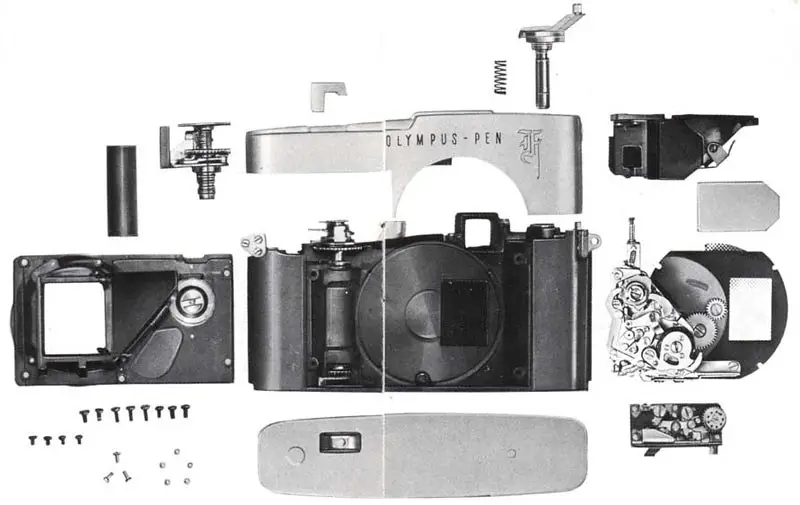
In his 2005 lecture archived on Olympus’s website, Maitani explains that in a regular 35mm SLR, the mirror flips on it’s long edge and it rises on it’s short edge. With a half-frame camera, everything is opposite. In order to maintain a traditional top mounted pentaprism with a mirror that flipped up, it would have to flip on it’s short edge, and the long side of the mirror would move forward which would cause an obstruction with the lens. In order to avoid the mirror from hitting the lens, it would have to be pushed much farther forward, increasing the overall size of the camera.
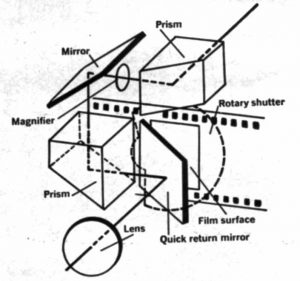
In order to maintain a compact size, the mirror needed to flip on it’s long edge, which meant it had to be rotated 90 degrees. By rotating the mirror 90 degrees, the prism would need to be rotated too. Although the prism and mirror was sideways, the viewfinder still needed to be in a familiar location on the back of the camera. In order to accomplish this, a Double Porro arrangement like that from a set of binoculars was used both to orient the image and also move it to where an eye piece could be conveniently located.
Now with the mirror and prism on the side, there was no room for a traditional horizontally traveling shutter, and a top mounted shutter like that of the Contax rangefinder would have negatively increased the height of the camera. To overcome this obstacle, a rotary focal plane design was chosen as it could be placed behind the prism, maintaining compactness.
Maitani and his team struggled to build the shutter, with early prototypes only able to hit a maximum speed of 1/50 which was far too slow. The shutter blade was originally made of steel and couldn’t rotate at the speeds needed to make a faster shutter speed, so later prototypes were made of aluminum. This allowed for faster speeds, but they quickly hit a wall in which the shutter would crumple upon the inertia needed to open and close the shutter at the required speeds.
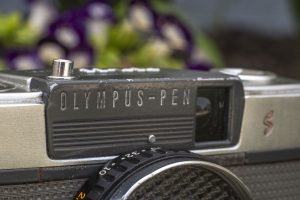
Eventually, titanium was decided upon as it was both lighter and stronger than aluminum. Early titanium prototypes were promising, allowing for a top speed of 1/300, but still short of their goal. In order to go higher, the titanium needed to be cut thinner than was commonly available. Eventually, Olympus found a supplier that could produce titanium with the required thickness, but it was not cheap, and the supplier could only make it in bulk, which required a substantial investment. Had Maitani and his team not been successful, it would have likely ended the development of the camera.
Thankfully, they were successful and with a combination of an extremely thin titanium shutter, and a specially designed spring made of Swedish Steel, a top shutter speed of 1/500 could be hit consistently and reliably.
When it was first released, the Olympus Pen F SLR received rave reviews in magazines and from photographers all over the world. In his regular column from the May 1964 issue of Modern Photography, Herbert Keppler leads off the first paragraph by saying the camera exceeded all expectations. Keppler peppers the article with words like “splendid”, “magnificent”, “excellent”, and “ingenious”. He declared the optional 50-90mm Auto Zoom to be the sharpest zoom lens he’s ever seen, and that the rest of the lenses were of superior performance.

Herb Keppler’s only complaint was that he had to pry the camera from his wife’s hands as she was constantly using it. He closes the review suggesting the photography industry needs to take 35mm half frame more seriously and that he would gladly wait in line to get his own camera when it went on sale to the public.
Maitani and his team’s success at building the Pen was both a blessing and a curse. Olympus owned all the patents required to build the shutter and viewfinder. This put the required technology out reach of any companies wanting to build a competing product. As a result, no other companies saw it worthwhile to create their own half frame SLR, and with film prices coming down and full frame SLRs become cheaper and smaller, ended the need for future half frame SLRs.
The Pen series was enormously successful and elevated Yoshihisa Maitani at Olympus as an innovative and talented designer. In the years after the Pen SLR’s release, Maitani was given additional projects including the the Olympus M1 SLR (later the OM-1) and the Olympus XA, both of which were very successful. Cameras within the Pen series continued to be produced into the early 1980s, at which time the market transitioned to compact point and shoot models.
On July 30, 2009, Yoshihisa Maitani would pass away, but his mark on the company would continue as that same year, Olympus would introduce a new line of digital point and shoot cameras known as the Pen using the micro 4/3rds system, a line that would stay in production until Olympus would exit the camera business in June 2020.
The following eight pages come from a Ponder & Best sales manual for the Olympus Pen FT, explaining the benefits of Olympus’s half frame SLR and showing many of the lenses and other accessories used for it. Although my review is for the earlier Pen F, I thought this was still relevant as all of the extra lenses and accessories were compatible with both models.
Today, the Olympus Pen series remains a popular choice for collectors. It inspired a re-birth of half frame cameras in Japan and around the world with models being produced by nearly every company in the world. The Pen F SLR, original Pen, and the “S” models are somewhat more collectible due to their better lenses and full manual controls, but any Pen in good working condition will likely attract attention from most collectors. Prices generally remain low for most models, so if you find a bargain on a working example, it is absolutely worth picking up.
My Thoughts
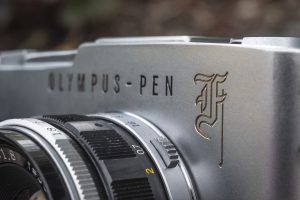
When it comes to lists of the most popular half frame 35mm cameras out there, you’ll likely find mention of the Olympus Pen F on it. Although it’s not the first half frame 35mm SLR I’ve reviewed on this site, it’s the only one that was part of a dedicated half frame system with a whole selection of interchangeable lenses.
There were a total of three Pen F SLRs, this one is the original model and for those who collect them, usually the favorite. Featuring a prominent “F” in gothic script on the front face of the camera, it lacks a light meter and is the only model with a double stroke film advance.
There is a lot to like about the Pen F, but one consistency with all cameras designed by Yoshihisa Maitani are it’s clean lines. I wouldn’t say minimalist, as that would suggest a camera lacking in features, but no matter what angle you look at the Pen F, every control, every surface, and every angle is purposeful.
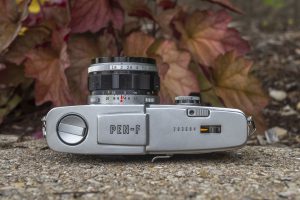
Starting with the top plate, there is the fold out rewind crank that has a bit of a concave shape that sinks into the top place, minimizing how much it sticks up above the rest of the place. In the center, where a pentaprism would normally be is a very tiny ridge, with the Pen-F logo nicely engraved into it. Off to the right is a rectangular exposure counter, the camera’s serial number, and along the front edge, the shutter release button with cable socket.
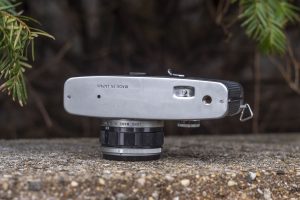
Flip the camera over and there’s not much to see on the bottom. From left to right is a 1/4″ tripod socket, rewind button, and a strange little hole that the user’s manual says is a tripod stabilizer. I assume Olympus made Pen specific tripods that stuck something in this hole to hold it steady as I’ve never seen anything like it on another camera. I find the inclusion of this hole and the offset tripod socket to be curious, as a centrally located tripod socket would have done a better job at stabilizing the camera. Perhaps there wasn’t enough clearance with the reflex mirror to put the socket in the middle though.
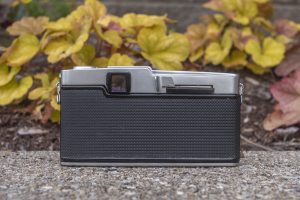
On the camera’s back, there is just the rectangular eye piece for the viewfinder and back mounted film advance lever. This being the original Pen F, this is a double stroke lever, which means you have to activate it twice for every exposure.
Double stroke cameras became popular in the early 1950s with cameras like the Leica M3 and Leidolf Lordomat as camera makers worried that the high-torque of a single stroke could damage film with a single wind. By requiring two strokes to fully advance the film, the amount of stress put on the film was reduced in half. This being a half frame camera in which the film only moves half the distance of a full frame camera, the inclusion of a double stroke lever is curious, and would disappear on both the Pen FT and FV models.
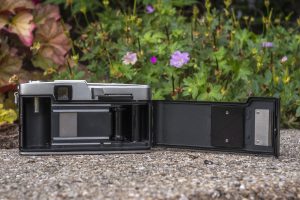
Opening the camera back requires an upward tug on the rewind knob and the right hinged door swings open. Film transport is from left to right onto a single slotted and fixed take up spool. By far, the most noticeable characteristic of the film compartment is the silver metal curtain of the Pen F’s rotary shutter within the half frame film gate. Unlike most SLRs which rely on either a horizontally or vertically traveling focal plane shutter, the Pen F’s shutter uses a design that pivots on a central axis across the film plane, not entirely unlike the rotary shutter in the Universal Mercury camera.
Rotary shutters have the advantage of being flash synchronized at all speeds, and are more consistent and theoretically more reliable than traditional shutters, but the problem with them is that in order to cover the image size of a 24mm x 36mm image on a full frame camera, they’d have to be very large, so they’re most commonly seen on half frame and some square format cameras like the Berning Robot series.

With such a clean top plate, you might wonder where you change shutter speeds, and that’s done with a large knob on the camera’s front plate. This location is reminiscent of the slow speed dial on the Leica III and it’s copies, except instead of just slow speeds, there’s all of them, from 1 second to 1/500 plus Bulb.
It’s not obvious at first glance, but around the outer perimeter of the shutter speed dial are two bayonet mounts which are there to allow attachment of an optional Pen F CdS exposure meter. With this meter attached, the meter reading is coupled to the shutter speeds, only requiring you to adjust the aperture to get correct exposure.
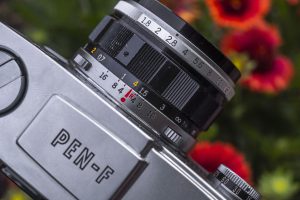
Pen F lenses resemble the layout of the company’s OM-system lenses in which a chrome ring showing f/stops is near the front edge of the lens. This is useful for people like me who tend to set a shutter speed and leave it there, allows for quick exposure adjustment with the camera to your eye. Behind the aperture ring is a thicker black focus ring. The overall shallow depth of the lens limits the size of the focus ring, but it’s certainly large enough to easily locate without having to fumble around for it. Finally, there is a small depth of field scale nearest the body.

Unlike many half-frame 35mm cameras that were designed to be an economical entry into photography, the Pen F was a system camera with a whole range of interchangeable bayonet mount lenses. On this example is the 38mm f/1.8 lens which compares to a 57mm lens on a full frame camera, but Olympus made a whole range of lenses from the 20mm f/3.5 wide angle to the 800mm f/8 mirror lens. There were even two zooms available and if that wasn’t enough, Olympus also made lens adapters for Nikon F, Exakta, M42 Screw, Leica M39, and T-mount lenses.
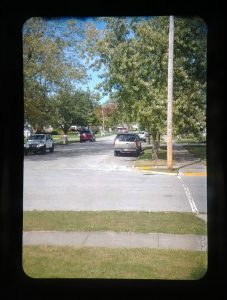
The viewfinder is one of the Pen F’s strongest attributes. Being a true SLR, what you see is exactly what will be captured on film regardless of lens. Focusing and composition is exactly the same as on other 35mm SLRs, except everything is sideways, even the reflex mirror. With the camera held to your eye with the top plate pointing towards the sky, images are in portrait orientation. To shoot landscape images, you must rotate the camera 90 degrees, exactly opposite of a full frame camera.
The viewfinder is decently large and bright, especially for an early 1960s SLR. I had no problems seeing all four edges of the frame even while wearing prescription glasses. The focusing screen has a faint Fresnel pattern to improve brightness, around a central ground glass circle in the middle. With the camera focused correctly, as in the image to the right, this central circle almost completely disappears. There is no other information visible in the viewfinder, nothing about selected shutter speeds or f/stops, and certainly no exposure information.
One of the complaints of the metered Pen FT is that the viewfinder is darker, as some of the light entering it must be reflected towards the mirror. With the unmetered FV, the brightness of the original F returned.
Probably the hardest thing to get used to with the viewfinder is something that applies to most half-frame cameras is that the orientation is opposite of what you’re used to. When the film transports horizontally, the camera makes portrait images. In order to shoot a camera in landscape orientation, you must rotate it 90 degrees, like you would with a full frame camera when shooting a portrait image. Take a look at the two selfies of me below. With the camera horizontal, the image is vertical, and when I rotate it, the image is horizontal.
A large number of half frame 35mm cameras were simple scale focus or rangefinder models with few of them SLRs like the Pen F. For those who are fans of the half frame format, the Pen F offers a compelling option, but it’s that SLR like experience with the vertical half frame viewfinder that can be jarring for some people.
It’s clear the Pen F is a well built camera with an excellent lens, but how is it to use, and what kinds of image does it make? Keep reading.
My Results
The Olympus Pen has an uncommon combination of SLR flexibility, but in an incredibly portable package. This makes for an ideal hiking camera as you can perfectly frame your landscapes, get some pretty good closeups, all while having something that fits into an average size coat pocket. For the first two rolls of film through the Pen, I took it with me on two separate hiking adventures. The first to Starved Rock State Park in Illinois and Turkey Run State Park in Indiana. Both times I loaded in Fuji 400 as I wanted a slightly faster film that would be better able to handle the dark shade that you’d often encounter on hiking trails in my area.
The Olympus Pen SLR is one of the more commonly reviewed cameras out there, and people regularly talk about how sharp of images they make, often suggesting that the level of detail in it’s images are almost indistinguishable from that of a full frame SLR.

The images certainly are sharp. While I wouldn’t agree that they’re indistinguishable when looked at on a high resolution monitor at 1:1, that’s not really how anyone should enjoy photography. For 99% of prints and how digital images of analog scans are consumed today, they look terrific.
For those of you who like to adapt vintage lenses to digital, Pen F lenses are a popular option not only because of their sharpness and clarity, but the focal length of the half frame lenses are an almost perfect match for APS-C “crop sensor” digital cameras like my Fuji X-T20 and Nikon D7000. I purchased a Pen F -> Fuji X-mount adapter specifically to use this lens and plan on writing a short review of it at a later time.
For now, the Olympus Pen F and it’s lenses are an excellent option for shooting film today. The clean lines and attractive look of the camera makes it feel more modern than it’s age suggests. The camera is incredibly compact, offering all the benefits of an interchangeable lens SLR system in a rangefinder form factor. This is a camera that can easily fit into a small handbag or large coat pocket, and at a weight of only 579 grams with the 38mm F.Zuiko lens, is one of the lightest mechanical SLRs ever made.
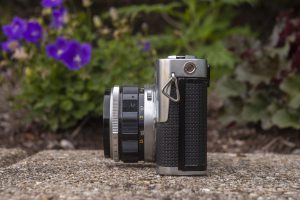
My nitpicks are minor and speak likely more to my personal preferences, rather than any shortcomings of the camera. I would have liked to have seen some kind of focus aide in the viewfinder. A split image rangefinder or even a microprism dot is better than nothing. I found the difference between the Fresnel parts of the focusing screen and ground glass circle to be indistinguishable in low light or when you’re very close to sharp focus. With the economy of a half-frame camera, looking at 48+ images on a 24 exposure roll of film, I did notice a few more slightly out of focus images that I would have liked.
I’m not also not in love with the location of the front shutter speed dial. While it certainly looks pretty, and helps to reduce clutter on the top of the camera, it’s location, combined with no indication of selected shutter speed within the viewfinder meant that I had to keep dropping the camera from my eye more than I would have liked. This of course is something that would likely come more natural with repeated use of the camera, but since we’re talking about nitpicks, I would have preferred either a different location or some indicator (even a Judas widow) within the viewfinder.
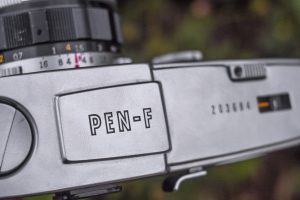
Finally, I question the need for a double throw film advance, especially on a half frame camera. I’ve used other double throw cameras before, but for some reason, I found that more often with the Pen F, I would forget to wind it a second time, meaning I would miss a potential shot.
Olympus wisely switched to a single throw on both the FT and FV, but I wonder what Maitani was thinking when he included this on a half frame camera. I get it on a full frame camera, as the torque can be a little high when pulling a piece of film 8 full perforations for a 36mm wide image, but on a half frame camera that only pulls it half the distance just seems like overkill (or underkill). It’s not a big deal, but does slow you down.
I realize I spent more time in this section with what I don’t like about the camera than what I did, but I can assure you, the positives definitely outweigh the negatives. The build quality is excellent, the location of the controls on the lens are excellent, and although I only had access to this one lens, from what I’ve seen, the line up of Pen F lenses was thoughtfully created with the utmost attention to quality in mind. This is a fantastic camera that looks great, has good ergonomics, is small and compact, and makes excellent images. Some people suggest that the Pen F is the best half-frame 35mm camera ever made, and that’s a point I won’t argue against.
If for some reason, you’re still undecided about whether to add a Pen F to your collection, just do it. I would be completely shocked if anyone ever regretted it.
Related Posts You Might Enjoy
External Links
http://camera-wiki.org/wiki/Olympus_Pen_F
https://www.cameraquest.com/olypenf.htm
http://www.klassik-cameras.de/Olympus_PenF_Lenses.html
https://casualphotophile.com/2020/08/28/olympus-pen-ft-review/

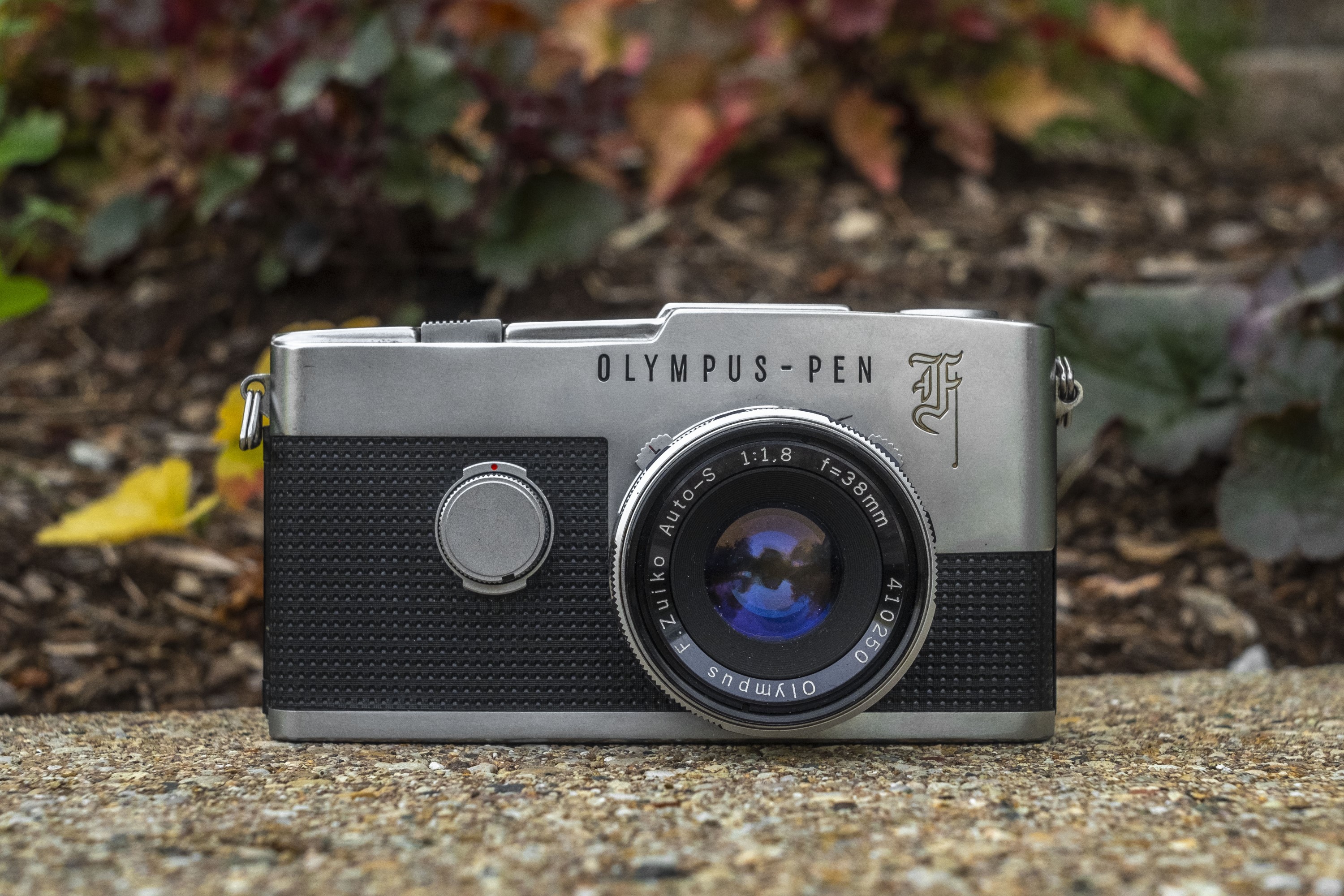
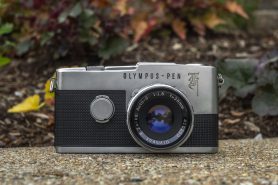

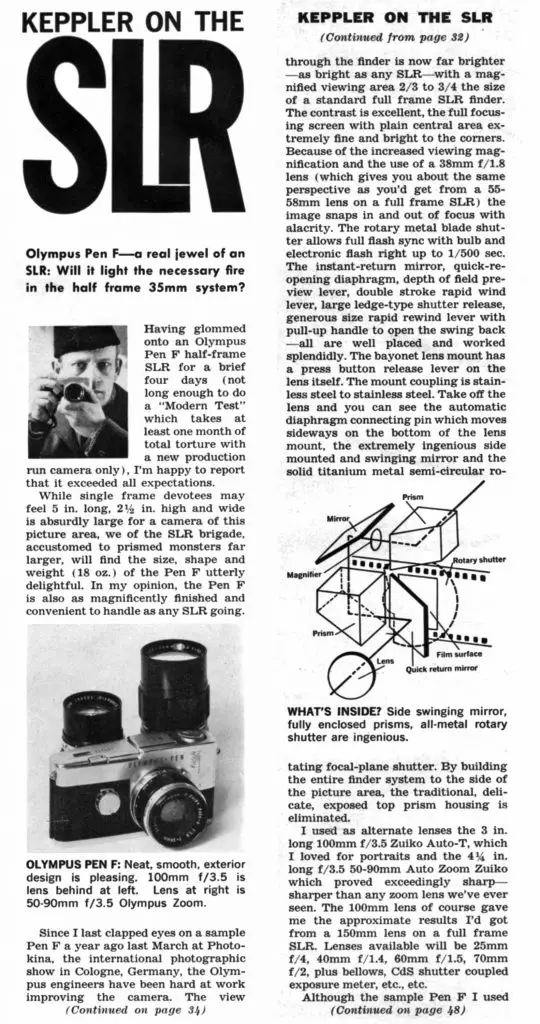
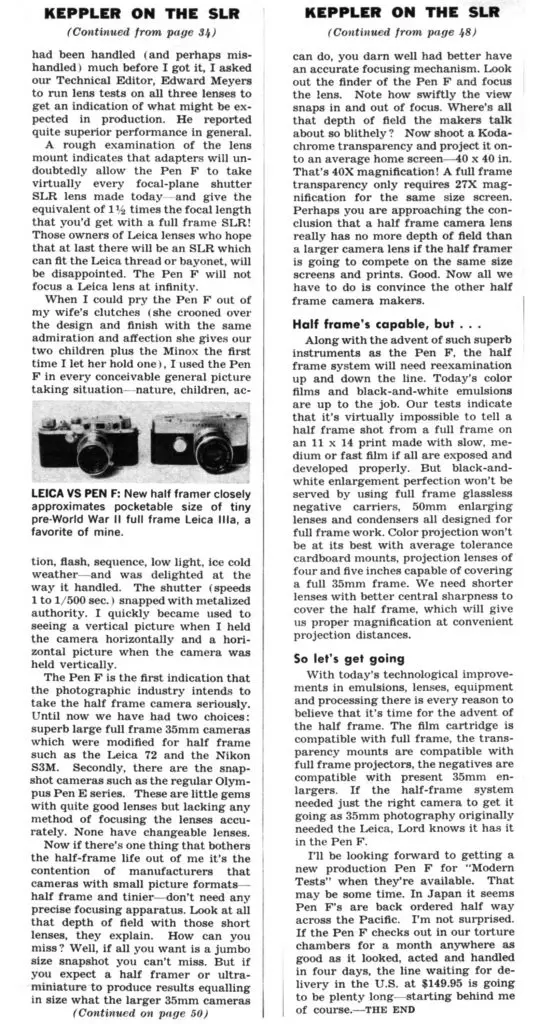
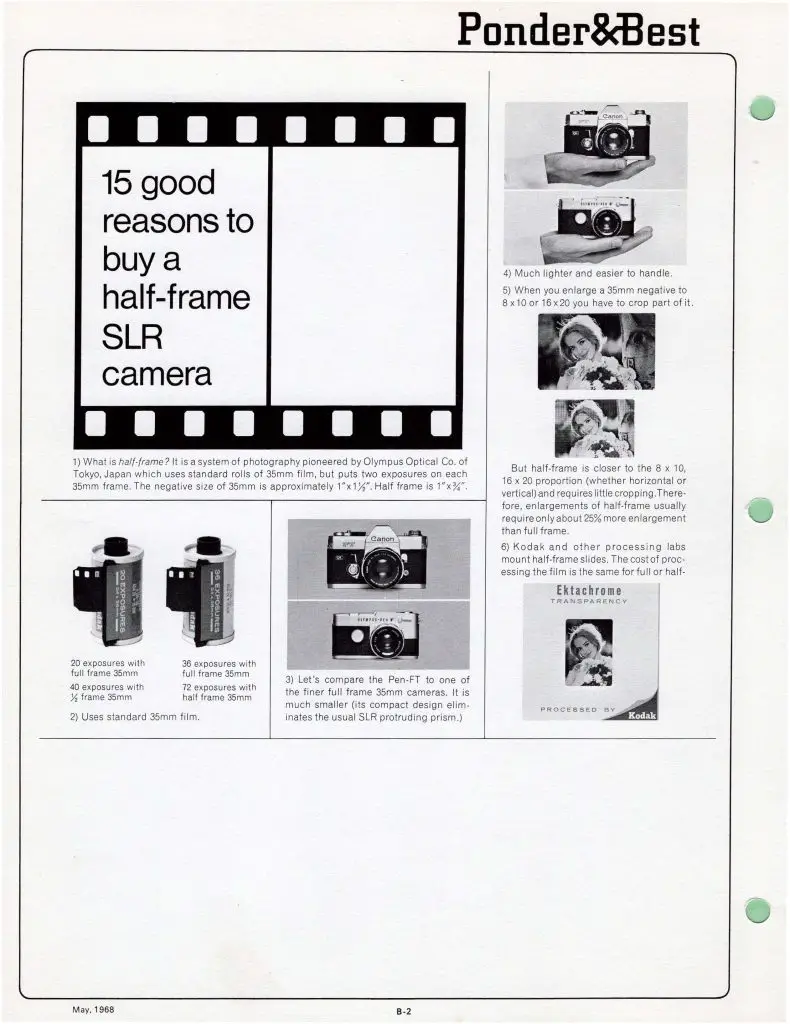
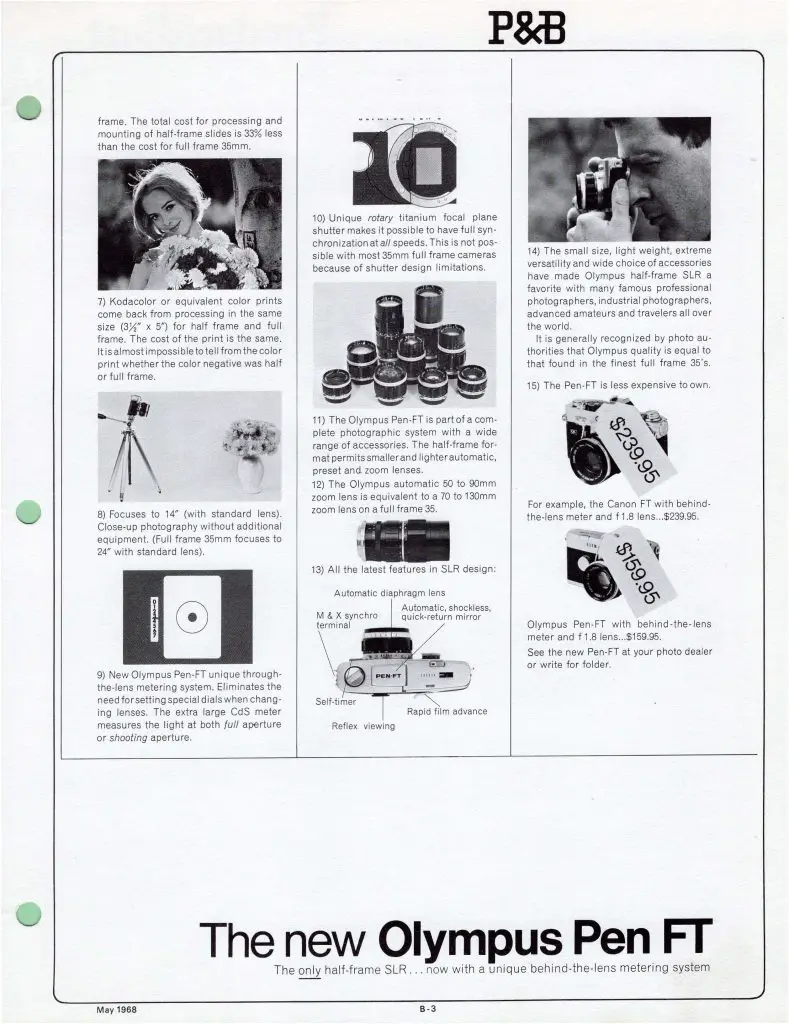
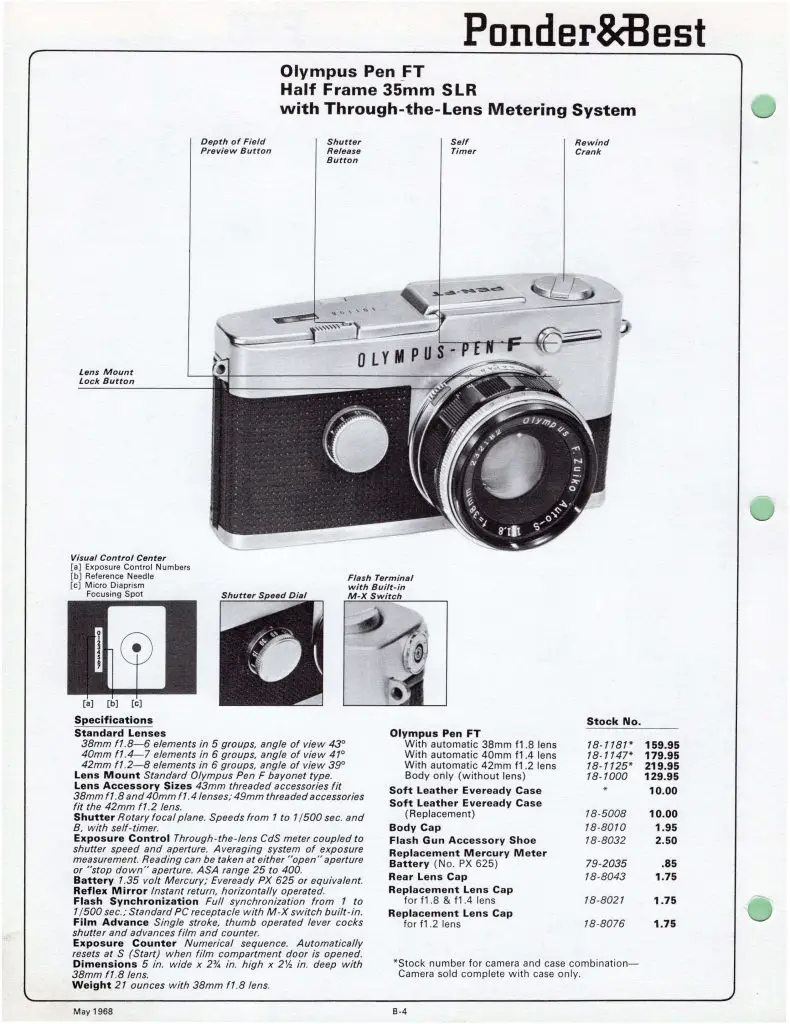
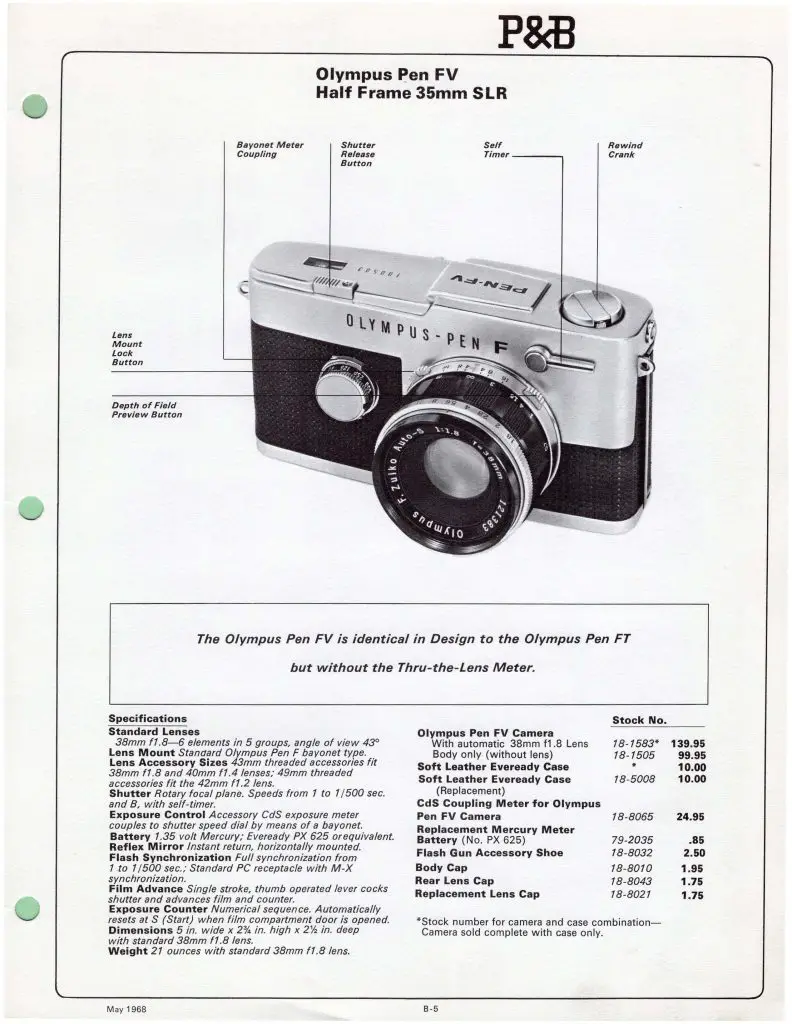
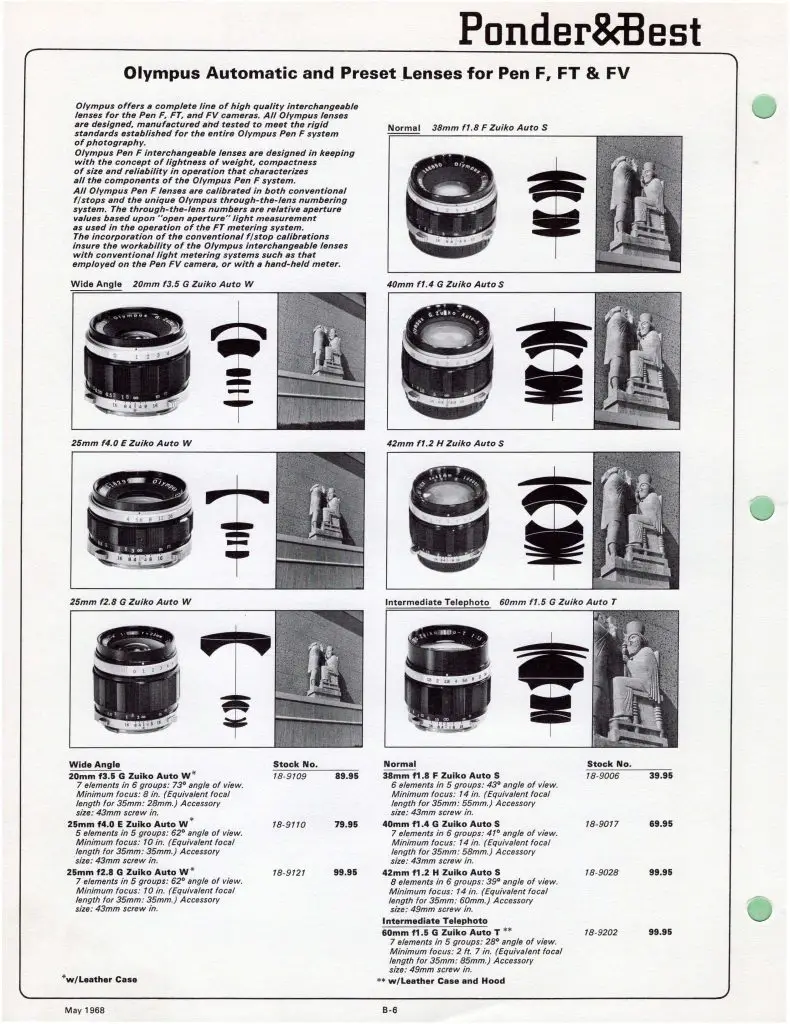
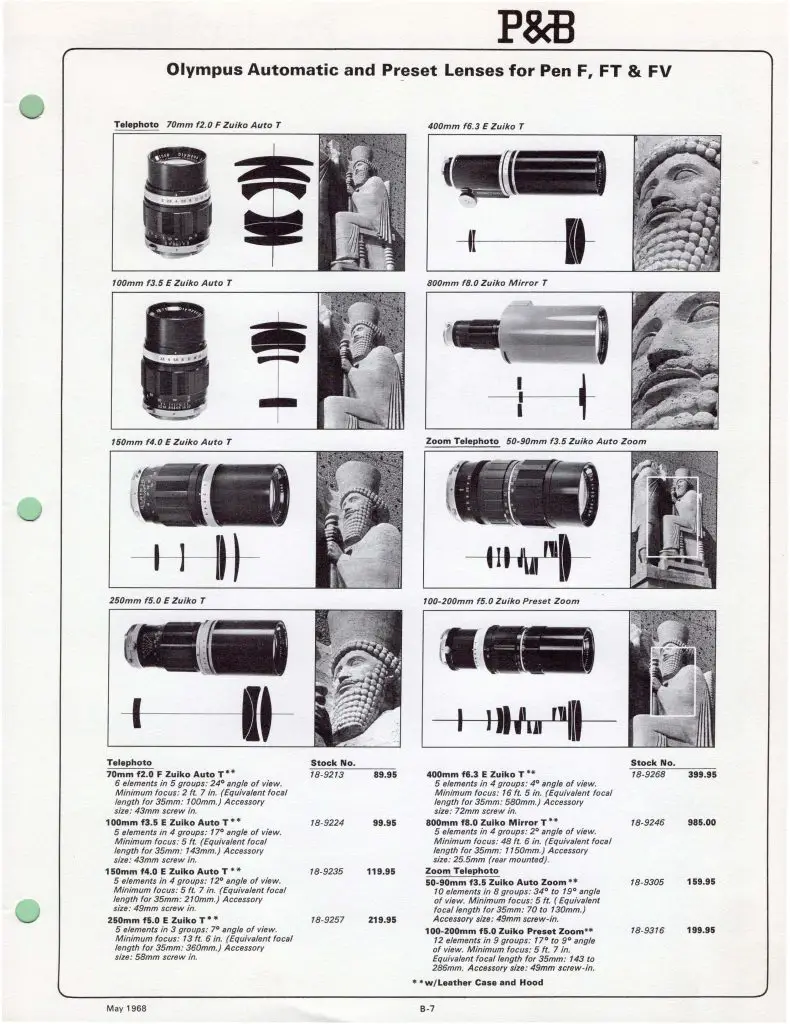

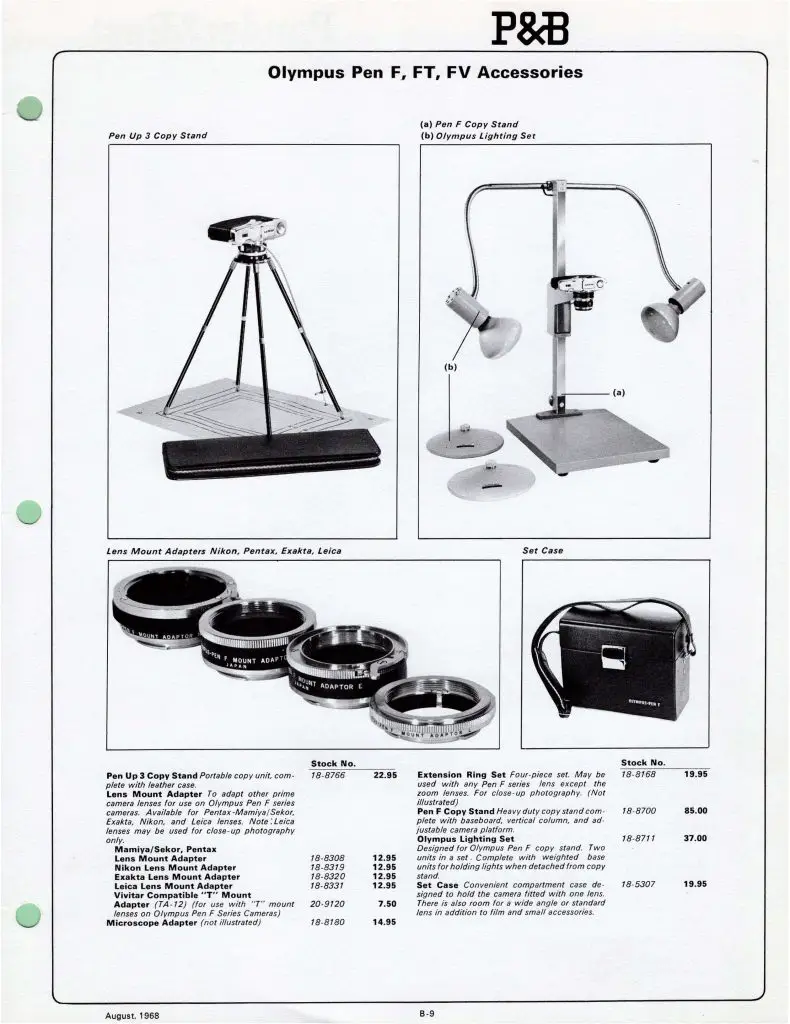
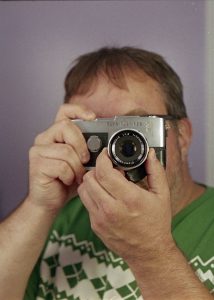
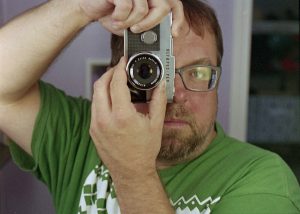















As a user of the recent digital Pen-F I really wanted to try the original. It took me a couple of attempts to get a fully working body and lens but eventually I got there. I wanted to like it, I really did, but for some reason I just didn’t get on with it. I loved it aesthetically but using it just didn’t spark anything and as I have too many other options I knew I wouldn’t use it and passed it on.
Don’t tell anyone, but I felt the same way. Even though my review is optimistic overall, there’s a reason it took me over 2 years to write this review and even after shooting the roll of images you see in it this summer, I’ve never felt compelled to come back to it. This will likely be a shelf queen. Sometimes there are those cameras that you know are special and you can absolutely see their merits, but they still don’t connect with you for reasons you really can’t put your finger on, and this is one of them. I almost feel ashamed admitting it as I know so many people love these things, but for me, this will live on as a shelf queen.
it is odd. It has so much going for it; well designed, compact, great glass (which I used on my digital for a while and was very happy) a great name and well featured but alas it was not for me.
Thanks for another great review Mike 🙂
Muy buena reseña Miguel! Pero, no diré nada de lo bien que has hablado de la cámara, solo diré (en mi modesta opinión) que el motivo de accionar dos veces la palanca de cargar la película, sea debido al minúsculo espacio que tendría en su interior, y Maitani optó por una cuerda a la mitad de recorrido. No sé cómo está construída esta cámara, pero, (supongo que ) no tendría espacio como para introducir una cuerda de un tiro completo… Ya que estamos en máquinas mecánicas y su elaboración es similar a la de la relojería de altísima precisión (!) creo que ese sea el motivo de hacer una cuerda “a la mitad”. Hay relojes de cuerda de un día, otros de tres días… y todos dan la hora perfectamente. El segundo punto de mi observación se refiere al visor. Será que el señor Maitani dejó pasar por alto algo tan trascendental como un visor (pentaprisma) de baja (o poca) visibilidad?.. Estamos hablando de una cámara hecha al inicio de los años sesenta, por lo tanto, de 60 años. Ya revisó la (posible) suciedad, hongos, polvo, moho que pueda tener ese visor? Incluído sus prismas y espejos? Un halo de moho es suficiente como para empañar su visión. Jamás una analógica será tan limpia como una digital nueva. Esperemos a que las digitales tengan 60 años de vida, y ahí, quizás – si estamos vivos aún -, podremos hacer una comparación de una y otra. Finalizando, no me lleve a mal, caro Miguel (!) Soy un lector asiduo de sus publicaciones y todas me agradan, incluso esta. Solo me sentí en el deber de cuestionar su opinión al final de su reseña.
Un gran abrazo!
Oscar.
Mike, I agree with your overall assessment of this camera. More for the collector nowadays, than a serious picture making tool. You touched upon the high cost of photography in post-WWII Japan and this will help explain the number of subminiature cameras using 16mm cine film, or even sub-miniature rolls of film with backing paper. Some of these are no more than toys, but others, such as those from Mamiya and Minolta, for example, were, are, proper photgraphic tools, and didn’t come about because of a Japanese love of all things small, or an interest in so-called “spy” cameras.
Regarding the position and functionality of the shutter dial, a comparison with that employed by Zeiss on their Contax 1 rangefinder of 1932 to 1936 is more apt, rather than the slow speed escapement of Barnack Leicas and their clones. They both provide a full range of speeds and are positioned roughly in the same place on the cameras’ bodies.
The Pen lenses really are brilliant. They had to be unusually sharp to work with the half-frame film size, and the fact that they didn’t have to cover the “full frame” 35mm size made the design problem a little simpler.
I have several of them, from the 38mm normal to the 40, 60 and 100mm telephotos. I use them on Olympus m4/3 cameras, and every one is amazing.
I’m not generally a fan of adapted lenses, so I wouldn’t go to the trouble unless they really did something special.
I’m old enough to have been around when I knew a few people using these back in the late 60’s. No doubt about the camera being “jewel like”, and everyone I knew, when they saw it, wanted to see more; BUT, and this is a big “but”, in an era where you couldn’t even “sell” 35mm full frame as a professional, it was just never going to be “long-term” successful. The amateur and “pro-sumer” market followed the pros, and the only pros using 35mm FF for anything were newspaper and magazine people, who had a out-sized reputation in people’s minds because of their access to the media! Most “feature” magazines didn’t accept anything smaller than 120, and of course commercial was mostly all sheet film; even wedding people were 120, no one would dare use a 35mm!
Everyone I knew shooting the Oly-Pen, eventually gave it up. One look at an 8X10 print from the half-frame, and that was that (and the attention to detail spent trying to get that was monumental). There were pretty good quality films, and the “trades” were full of experiments on all sort’s of film developers for both lack of grain, and improved sharpness; but blowing up that half-frame to an acceptable size was an exercise in frustration. Even the defenders were vocal about how great a camera it was, but just for 4X5 prints, maybe 5X7 on a good day.
The M4/3rd’s system seems to have become the true fruition of this thinking, and even as a “pro”, I bought heavily into it for my own uses! Imagine my pain at hearing that Oly is now out of the camera business. I’m left with a lot of nice lenses to use on Panasonic cameras. Maybe the almost “non-understandable” and “confusing” setting on the digital Pen hastened this! I certainly think it’s a monumentally confusing camera! Maitani would have been disappointed…
Andy, I couldn’t agree more. 35mm was excellent for its intended final use in newspapers with their extremely low resolution printed images and which didn’t require a high resolution input. The minimum acceptable standard for the glossy colour mags was 120 although Kodachrome 35mm could just make the grade in some less demanding scenarios. But what worked against 35mm slides was trying to view them on a light box. It seems picture editors weren’t keen.
My first forays in photography, 1960, with 35mm, didn’t inspire me, and this wasn’t helped by the cheap cameras I used. But I knew of certain well known professionals at the time who used TLR’S, Rolleiflex, which I simply couldn’t afford and this is how I got into MF with a nice new YashicaMat in 1963. At last I was able to get high quality 10×8 prints with relative ease, and consistently, which I never would be able to achieve later, even with quality 35mm cameras.
Terry B! Exactly! I waded through a lot of 35mm’s over the years, altho made all my professional money with sheet film and 120. I remember in high-school and college, doing whatever it took to get the best printable negs: exotic developers, only processing during the full moon, whatever the guru’s were telling me. But I certainly remember my first commercial photo studio job, one of my duties being processing the film and printing. The first film I did was 120, and when I went to print it, it was turing a light-bulb on! It took about 10% of the effort of 35mm to get superior film and prints!
Interesting to note, when I started my own studio, after buying sheet film equipment, I saved up for a decent Hasselblad system. When I look back on my entire career and what I shot with that camera: I would say about 25% of the subjects were shot with the 150mm, about 60% with the 80mm normal, and the remaining 15% split between the 250mm and the 50mm! It’s certainly no great leap of faith to realize how the “normal” only 120 TLR was a great choice, and how Irving Penn and Avedon did so much great work with it! I recommend today to students that want to shoot film, and I an a Minolta Autocord fan (owned 5 at one time, but unfortunately down to 1). I belive Mike has a great entry on the Autocord on this site!
Andy, very interesting to read about the various focal lengths you used with the Hasselblad. After 15 years and getting through 2 ‘Mats (amateur use) I got a nice Mamiya C330, first model because the idea of having interchangeable lenses appealed, along with the built-in close up facility. I got the 55mm and 180mm to complement the 80mm. However, it didn’t take me long to realise that after 15 years of honing my skills with a fixed lens tlr, I didn’t really find the interchangeable lens option all that much of an advantage. But the bellows close up proved its worth. I kept faith with the C330 series taking me to the final model, the C330S. But I also did not get any additional lenses for it.
This didn’t stop me along the way getting a Rolleiflex 2.8E2 with the Xenotar, and a Rolleiflex 3.5f with Planar, after the 2.8E2 financed my foray into 5×4, an MPP Mk VIII rangefinder.
In 1963, in the UK, a Minolta Autocord was 25% more than a YashicaMat, and which was a significant factor in favour of the YashicaMat for an 18 year old. More than that, though, was the handling. I did not warm to the Minolta method for focusing. However, time has favoured the Minolta if you have one for sale, not so good for buyers.
Terry, I have to say I owned a late series Yashica 124, which altho not being made, was still being sold by the big NYC camera stores, new! For a long time, I actually used a few images from it in my “pro” portfolio, the last series lenses were no dogs, they were very nice. The deal with the Minoltas were that the lenses they came with were so good, people were saying that they had better quality than most of the lens offerings on the Rolleicord! I’m keeping my last Autocord and taking my own advice to students: using it to shoot film today!
Does anyone know if the viewfinder is 100% (or at least close to it)? Like the Nikon F2 and F3, that’d be a big plus for me. BTW, I have a few of the original (non-SLR) Olympus Pens and Pen Ss and they’re super fun to use.